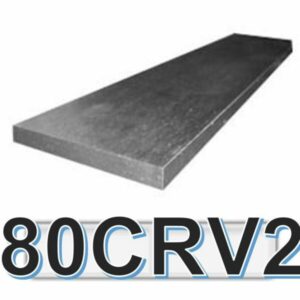80CrV2 is a popular tool steel known for its excellent combination of toughness, wear resistance, and ease of heat treatment. To fully harness its potential, understanding the proper heat treatment process is essential.
In this blog post, we will provide a comprehensive guide on heat treating 80CrV2, including specific temperatures, techniques, and practical tips to achieve optimal results.
Understanding 80CrV2
80CrV2 is a medium-carbon, chromium-vanadium tool steel. It contains 0.80% carbon, which contributes to its hardness and wear resistance, while chromium and vanadium enhance its toughness and strength. This steel is widely used in applications such as knives, blades, and hand tools.

80CrV2 Chemical Compositions
The chemical composition of 80CrV2 steel typically includes the following elements:
- Carbon (C): 0.75% – 0.85%
- Chromium (Cr): 0.50% – 0.80%
- Vanadium (V): 0.10% – 0.25%
- Manganese (Mn): 0.20% – 0.50%
- Silicon (Si): 0.15% – 0.35%
- Phosphorus (P): Maximum 0.025%
- Sulfur (S): Maximum 0.025%
Annealing
To begin the heat treatment process, annealing is recommended to relieve internal stresses and refine the steel’s grain structure.
Heat the 80CrV2 to around 800-850°C (1472-1562°F) and hold it at that temperature for a sufficient time to ensure uniform heating. Slowly cool the steel in a furnace or by burying it in insulating materials to achieve a soft and machinable state.
Austenitizing
Austenitizing involves heating the steel to a specific temperature range to transform the microstructure into austenite, a high-temperature phase.
For 80CrV2, the recommended austenitizing temperature is typically between 800-840°C (1472-1544°F). Ensure that the entire steel piece reaches the desired temperature for uniform transformation.
Quenching
Quenching is a critical step that determines the hardness and toughness of the steel. Rapidly cool the austenitized 80CrV2 by immersing it in a suitable quenching medium, such as oil or water-based solutions.
- Hardening Temp (Furnace): 830-880°C [1,525°F – 1615°F]
- Sweet spot: 840°C [1544°F]
- Soak time: 5min (2.5mm) to 10min (5mm)
The choice of quenching medium depends on the desired hardness and the section thickness of the steel. Thicker sections may require slower quenching rates to prevent cracking.
In the quenching heat treatment cycle for 80CrV2 steel, the recommended austenitizing temperature is between 800-840°C (1472-1544°F). The steel should be held at this temperature for a sufficient time to ensure complete transformation.
“Common cooling media include oil for a balance of hardness and toughness, and water or brine for higher hardness. “
Tempering
After quenching, the steel will be extremely hard and brittle. Tempering is essential to reduce brittleness and enhance toughness. Heat the hardened 80CrV2 to a specific temperature range between 200-300°C (392-572°F), and hold it for an appropriate time.
The exact tempering temperature and time depend on the desired hardness and toughness, considering the specific application requirements.
Tempering Temperature Recommendations
- For a hardness of 62HRC, temper at 150°C (300°F).
- For a hardness of 61HRC, temper at 180°C (350°F).
- For a hardness of 60HRC, temper at 200°C (400°F).
It is important not to exceed the recommended tempering temperatures as doing so can result in tempered martensite embrittlement, leading to decreased toughness scores. It is advised to temper the steel two times, with each tempering cycle lasting two hours.
Depending on the intended use, it is recommended to achieve a hardness range of 58-60HRC after tempering. A lower hardness is suitable for tough prybars, while a higher hardness is preferable for sharp slicers that primarily perform slicing tasks rather than chopping.
A summary of Heat treatment temperature is:
| Heat Treatment Process | Temperature Range (Celsius) | Temperature Range (Fahrenheit) |
|---|---|---|
| Annealing | 800-850°C | 1472-1562°F |
| Austenitizing | 800-840°C | 1472-1544°F |
| Tempering | 200-300°C | 392-572°F |
Multiple Tempering Cycles
For precise control over hardness and toughness, multiple tempering cycles can be employed. This involves repeating the tempering process, adjusting the temperature and time for each cycle. Each tempering cycle imparts specific properties to the steel, allowing for fine-tuning to achieve the desired balance between hardness and toughness.
Post-Treatment Operations
Once the heat treatment process is complete, further operations such as machining, grinding, and polishing can be performed to achieve the desired final shape and surface finish.
